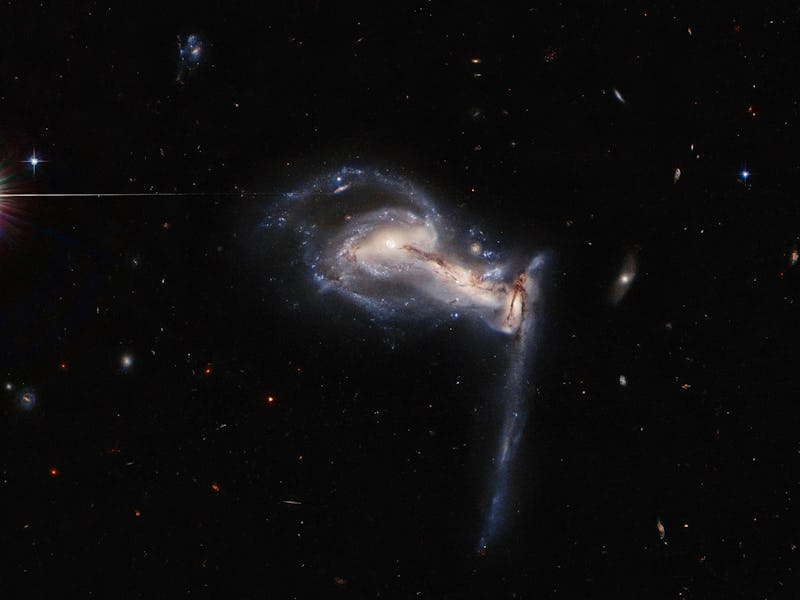Hubble captures 3 galaxies caught in a gravitational tug of war
A new image hints at the cosmic fate of the Milky Way.

Even in the possibly infinite universe, galaxies still fight over space.
The Hubble Space Telescope recently captured three massive galaxies having an intense tug of war, with each one dragged by the intense gravitational pull of the other.
The stunning image is an example of what happens when galaxies get too close. It also shows a glimpse of our own galaxy’s eventual fate, predicted for 4.5 billion years from now.
NASA shared the image of the three-way galactic cluster on Friday.
Hubble captured the image as a “bonus snapshot” in between its longer observation times. These bonus shots are more than spectacular: They help the team behind the space telescope to decide on Hubble’s next target for extended observation periods.
The Hubble Space Telescope is jointly run by NASA and the European Space Agency (ESA). The new image is also a feat in technological resilience and ability: The cluster was captured just two weeks after Hubble returned to operation after a five-week pause in operations. In July, the Hubble team switched the spacecraft to backup hardware after an issue with its payload computer.
Here’s the incredible snapshot:
These galactic siblings are having a bit of a squabble, tugging at each other with their gravitational force.
What the image reveals — The galaxy cluster is known as Arp 195. It is located in Lynx, a constellation named for the animal, usually observed in the Northern celestial hemisphere. Arp 195 lies approximately 389 light-years away from Earth.
Arp 195 is also featured in the Atlas of Peculiar Galaxies, a catalog of the strangest looking galaxies captured by our Earthly telescopes. The catalog was released in 1966 with 338 galactic oddballs.
But Arp 195 stands out as peculiar: a galactic cluster made up of three galaxies pulling at each other through the sheer force of their gravity.
A gravitational tug of war — The three galaxies became caught in this gravitational embrace after they came too close to one another.
This video was created by the Hubble team to show off the snapshot.
The force of gravity of an object depends on its mass, and every object in space exerts a gravitational pull on its surrounding objects.
Galaxies are a huge collection of gas, dust, and billions of stars held together by gravity. If two or more galaxies get too close to one another, the gravitational force of the larger galaxy of the group will begin to pull on the gas of its galactic companions.
The pull creates what is known as a “leading arm.” This is seen in the image as a streak of gas that connects the galaxies.
Eventually, the galaxies will merge as one, creating an uptick in the production of stars and the amount of gas in the galaxy.
Will the Milky Way collide with Andromeda?
Nearly 14 billion years ago, our galaxy — the Milky Way — formed from enormous clouds of gas and dust collapsed under the weight of gravity.
These clouds then formed two main structures: a spherical halo, and a dense, bright disk.
A popular theory suggests that around 11 billion years ago, a small galaxy called Gaia-Enceladus slammed into the primordial Milky Way.
This may have continued to happen throughout the galaxy’s history. Astronomers believe that several smaller galaxies collided with the Milky Way over the years, leading to its massive structure today.
The most recent collision may have happened 3 billion years ago when a dwarf galaxy crashed into the center of the Milky Way.
And in about 4.5 billion years, the Milky Way is predicted to collide with its neighbor; the Andromeda galaxy. This is based on a 2019 assessment made by the ESA.
This NASA animation depicts the predicted crash between the Milky Way galaxy and Andromeda.
The Andromeda galaxy is a barred spiral galaxy that lies approximately 2.5 million light-years from Earth. It is the closest major galaxy to the Milky Way.
The two are predicted to plow into each other, flinging the Sun into a different region of the galaxy while the Solar System itself stays intact. The stars inside each galaxy are so far apart that they will likely not collide with one another.
But the stars will be thrown into different orbits around the center of the galaxy.
It will take an additional two billion years after the initial crash for the two galaxies to completely merge as one and reshape into a single elliptical galaxy, according to NASA.
Meanwhile, the three galaxies caught by Hubble may have some time before they also become one.
This article was originally published on